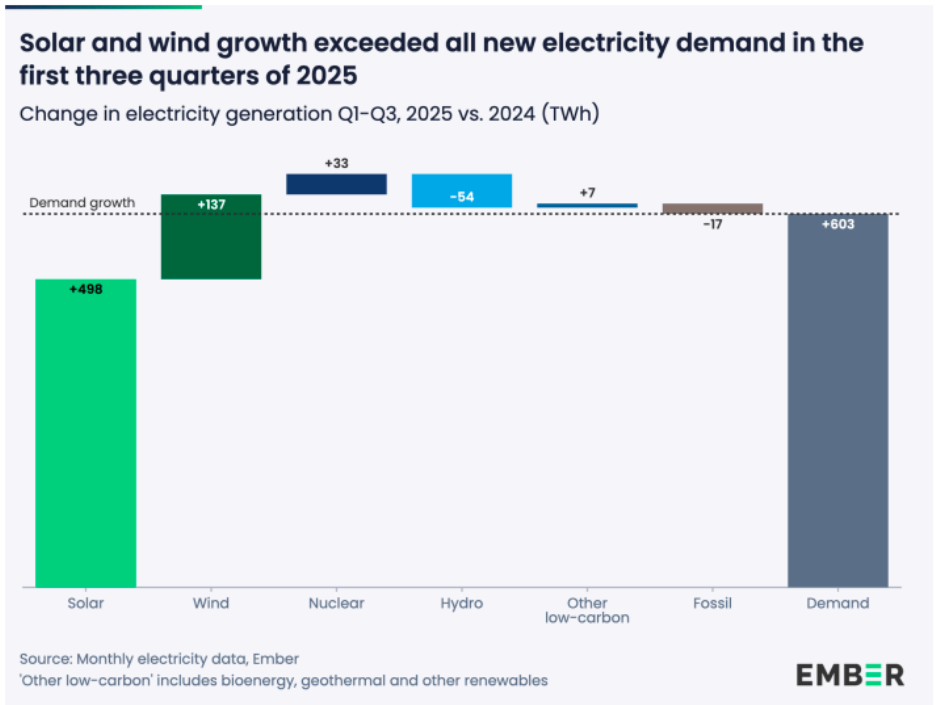Solar and wind power have grown rapidly enough to meet all new global electricity demand in the first three quarters of 2025, according to analysis by Ember. The report marks a historic milestone, forecasting that fossil fuel power generation will not rise for the first time since the Covid-19 pandemic, Nicolas Fulghum, Senior Data Analyst at Ember, said.
Here are ten key takeaways from Ember’s findings.
Solar and Wind Outpace Electricity Demand
Global solar and wind generation expanded by 635 TWh in the first three quarters of 2025, surpassing the 603 TWh increase in global electricity demand. This indicates that renewable energy growth exceeded demand growth for the first time in modern history.
Strong Solar Power Growth
Solar generation surged by 498 TWh, representing a 31 percent increase from last year. This expansion alone exceeded the entire solar output recorded in 2024, positioning solar as the leading source of new electricity generation worldwide.
Wind Power Expansion Continues
Wind generation rose by 137 TWh, up 7.6 percent year-on-year. While not as dramatic as solar, wind energy’s steady rise continues to reinforce the shift toward cleaner power sources.
Renewables Supply 43 Percent of Global Electricity
In total, low-carbon sources including solar, wind, hydro, bioenergy, and geothermal contributed 43 percent of global electricity in 2025, up from 41 percent in 2024. This marks another step toward decarbonizing global power systems.
Fossil Fuel Share Declines
Fossil fuels generated 57.1 percent of global electricity in the first three quarters of 2025, compared to 58.7 percent in the same period last year. The drop underscores the gradual but steady retreat of coal, oil, and gas in power generation.
No Growth in Fossil Generation Expected
Ember forecasts that 2025 will see zero growth in fossil fuel generation globally, breaking the pattern of rising fossil power that has persisted for decades. Fossil output declined slightly by 0.1 percent, or 17 TWh, during the period.
China and India Lead the Shift
Fossil generation in China dropped by 52 TWh (-1.1 percent), while India recorded a 34 TWh (-3.3 percent) decline. These reductions offset minor increases in fossil output in the EU and the US, driving the global stagnation of fossil fuels.
Structural Change in China’s Power System
China’s clean energy generation met all new electricity demand in 2025, signaling a structural shift in the country’s power mix. This indicates a turning point where economic and energy growth are no longer tied to fossil fuel expansion.
Mild Weather Curbed Demand Growth
Global electricity demand rose by 2.7 percent in 2025, down from 4.9 percent last year. Milder temperatures in major economies such as China, India, and the US helped reduce the need for cooling, easing overall demand pressure.
Solar Becomes the Core Driver of Global Power Transition
Solar energy now stands at the center of global electricity transformation, contributing more than three times the growth of any other power source. According to Ember, this marks the start of a new phase where fossil power enters managed decline, and clean power leads global electricity generation growth.
Ember’s analysis highlights that 2025 may be remembered as the year when solar and wind energy fully met global electricity demand growth for the first time, signaling a significant step toward a cleaner and more sustainable global power system.
Baburajan Kizhakedath

